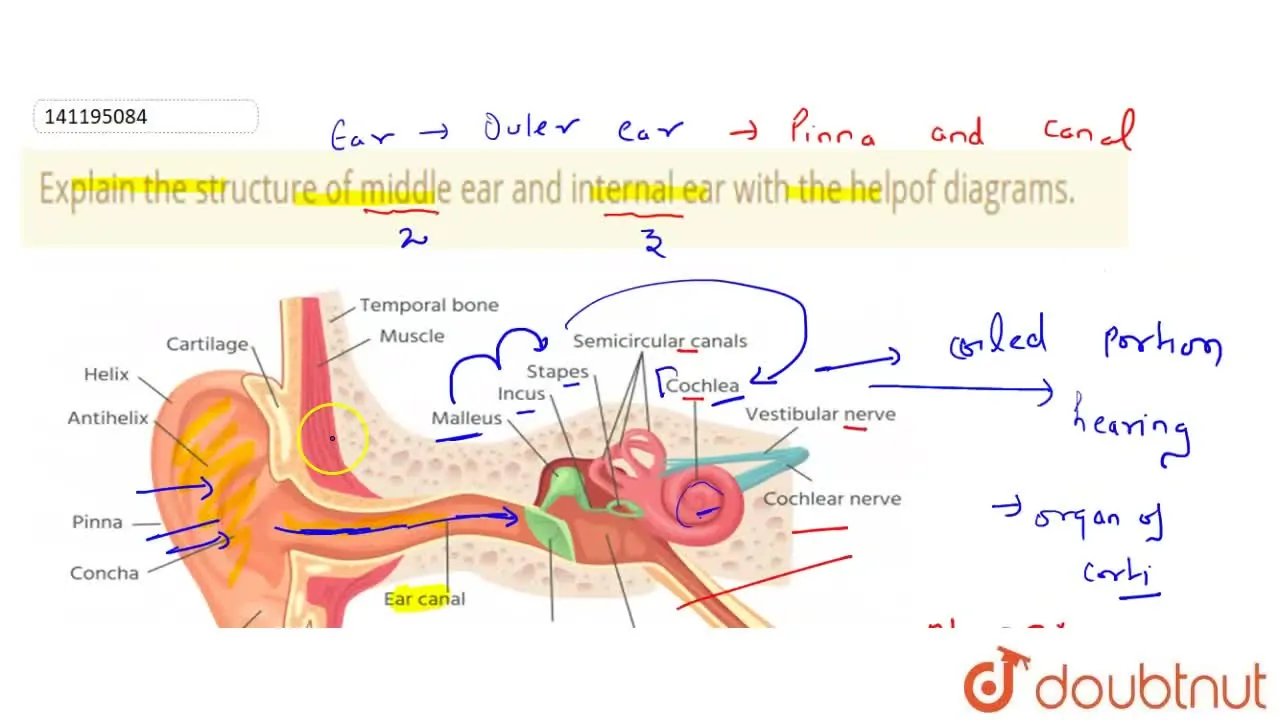Explain the structure of middle ear and internal ear with the helpof diagrams.
Video Solution
Text Solution
Ear are a pair of statoacoustic organ meant for both balancing and hearing. In most mammals the external ear is a leap of tissue also called pinna. It is a part of auditory system. The human ear consists of three main parts external ear, middle, ear and internal ear.
Structure of Middle Ear
The middle ear contains three bones or ossicles - the malleus (harmmer), incus (anvil) and stapes (strill -up). These bones are attached to one another in a chain -like fashion. The malleus is attached to the tympanic membrance and the stapes is attached to the oval window ( a membrane beneath the stapes ) of cochela. These three ossicles increase the efficiency of transmission of solud waves to the inner ear.
The middle ear also opens into the Eustachian tube, which connects with the pharynx and maintains the pressure between the middle ear and the outside atmosphers,
Structure of Internal Ear.
The inner ear consist of a labyrith of fluid -filled chambers with temporal bones of the skull. The labyrinth consist of two parts, i.e., the bony and membranous labyrinth. The bony labyrith is a series of channels.
Inside these channels, membranous labyrinth is filled with a fulid called endolymph. The coiled portion of the labyrinth is called cochlea.
The conchlea has two large canals-an upper vestibular canal (scala vestibuli) and a lower typanic canal (scala typmani) -separated by a smal cochlear duct (scala media). The vestibular and tympanic canals contain perilymph and the cochlear duct is filled with endolymph.
At the bases of scale vestibuli, the wall of membranous labyrinth comes in contact with the fenestra ovalis, while at lower end of scala tympani lies the fenestra rotunda.

|
Updated on:21/07/2023
Related Playlists
- BOOK - NCERT EXEMPLARCHAPTER - NEURAL CONTROL AND CO-ORDINATIONEXERCISE - SHORT ANSWER TYPE QUESTIONS6videos
NEURAL CONTROL AND CO-ORDINATION
- BOOK - NCERT EXEMPLARCHAPTER - MORPHOLOGY OF FLOWERING PLANTSEXERCISE - Long Answer Type Questions8videos
MORPHOLOGY OF FLOWERING PLANTS
- BOOK - NCERT EXEMPLARCHAPTER - PHOTOSYNTHESIS IN HIGHER PLANTSEXERCISE - Long Answer type Question13videos
PHOTOSYNTHESIS IN HIGHER PLANTS
Similar Questions
Explain the structure of middle ear and internal ear with the helpof diagrams.
View SolutionMiddle ear has
View Solutionboth middle and internal ears occur in
View SolutionMiddle ear contains
View SolutionDescribe the internal ear of man with the help of a labelled diagram .
View SolutionBriefly describe the structure of ear with the help of a suitable diagram.
View SolutionStructure Of Human Ear
View SolutionThe other name of internal ear is :
View SolutionSound is transmitted from middle ar to internal ear due to
View Solutionmiddle ear and tympanum are absent is
View Solution


